If you follow me on Facebook, you’ll know that John and I do enjoy a good meal. And, you’ll also have seen that eating out in Mexico goes way beyond the expected tacos and burritos:
You’ll also know that we like to cook:
However, before cooking, one must shop. And shopping for food in Mexico can be quite an experience – if you want it to be.
It all depends how you want to approach food provisioning, coupled with your individual level of bravery and willingness to explore. One of the first hurdles is learning what’s actually available and where, then adjusting your plan to either include the local stuff that you may never have seen before, or finding out where the imported stuff is available and being ready to pay a premium price for that[1]. (That [1] indicates a footnote – click on it to see the note, then click on the [1] again to come back to this point).

Can’t be found in regular groceries, spied in a specialty shop for just under $4 U.S. a can.
Following are my observations– starting with big providers and working towards the small providers (where the fun is):
Big Box Stores
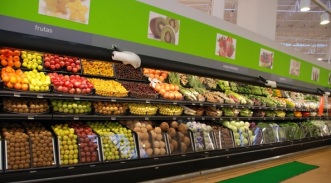
Soriana produce
If you are a casual visitor, perhaps in a condo or all-inclusive for a week, you may not be cooking much on your own. Even so, you may want to stock up on snacks and beverages. In that case, you are more likely to go to one of the local big box stores for no other reason than choice and convenience. In the Bahia de Banderas that means Mega, Soriana, WalMart, Chedruai or even Costco and Sam’s Club. Here your shopping experience is likely to be very similar to your experience in the US or Canada – large produce section, push carts to fill to the brim (sometimes with a sticky wheel – just like home!), aisles organized by some sort of theme, liquor section, meats shrink-wrapped and sorted nicely into beef, chicken, pork, fish, etc.
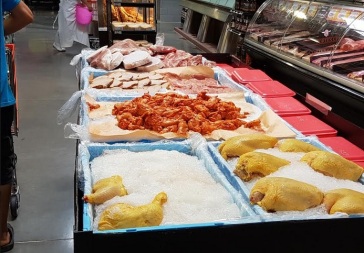
Porkchops (fresh and smoked), chicken wings, and chicken parts. Grab-n-go!
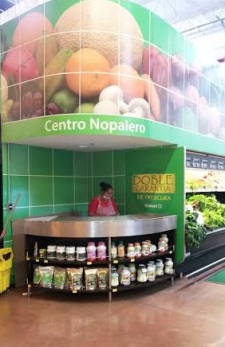
WalMart’s Nopale Center (San Jose del Cabo)
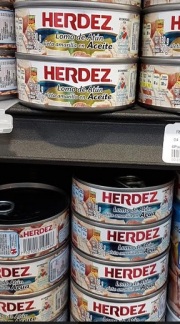
Oil (aceite) or water (agua)?
Of course, you have to adjust to labels all in Spanish – once a couple approached me with two cans of tuna and asked if I could tell them which one was in oil – so it helps to have some basic Spanish or a dictionary/phone translation app handy.
You also have to learn the layout of the big stores – I joke that a trip to Mega is like a scavenger hunt. Yes, I know I want mayonnaise. Yes, I know the general location of the condiment section. But is it with the ketchup and mustard? Or is it in the canned fish aisle? Or is it with the salad dressings? Layouts vary store to store.
The meats are available as pre-packaged – it’s easy to pick up a cello-wrapped packet of four bone-in pork chops (after you figure out that you are looking for something labeled “chuleta de cerdo”) or two chicken breasts (“pechuga de pollo”). There are whole sections for cheese, another section for yoghurt – like I said – you’ve been there, done that (mas o menos) at your local grocery store.
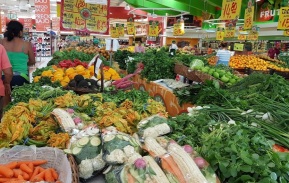
Wednesdays at Mega, Bucerias
A quick side note about the chickens in Mexico – whatever they eat here makes the skin and fat very yellow. Think marigold yellow. When you see U.S. chicken again it will look anemic in comparison.
Although…sometimes the displays can be disconcerting – like seeing nuclear yellow chickens, unwrapped, on ice, on a table in the middle of the meat section. Or bags of pigs’ feet and packages of cow tongues.
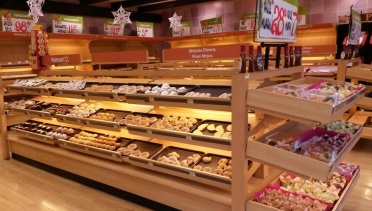
WalMart bakery section
Quick note about the bakery sections in big stores – be sure to grab a tray and tongs (usually near the bakery’s checkout counter). Make you selections, then return to the counter. The attendant will pack up your items and mark the price for the checkout line.
The big stores even have organized lines at the checkout, and you can use your plastic money. In high season (November – April) half or more of the shoppers are gringos. You’ll feel very much at home.
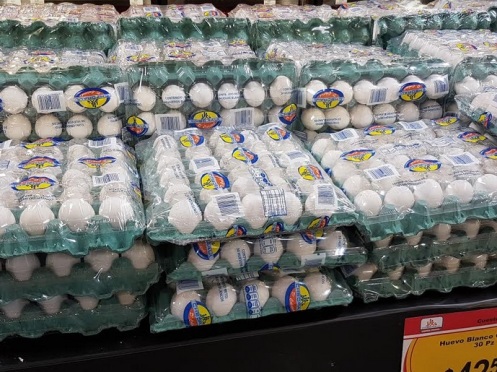
Eggs at Chedraui. $42.50 for a flat of 30 eggs is approx. $2.25, or about 92 cents US for a dozen.
Also be aware that at the big stores, the people bagging your purchases are “volunteers” working for tips. Many are retirees. Be sure to drop a few pesos their way. I typically leave 5 pesos if I only have a couple items in one bag, up to 20 pesos for a large shopping excursion.
And yes, by all means bring your own re-usable bags.
Neighborhood Tiendas
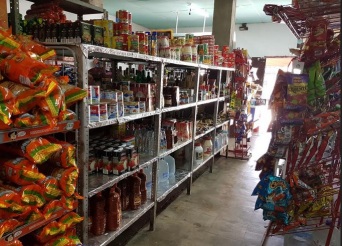
Welcome to your local tienda – a little bit of a lot of things
I love these guys. They have a little bit of almost everything you need to make it through the day. Yeah, it costs a bit more but they are just down the street, and they are owned and operated by your neighbors. At Mega you can get a half- or one-kilo bag of pre-packaged rice. At the tienda, they buy a HUGE bag, open it up, portion it out into one or two kilo bags[2]. At Walmart there is a whole aisle devoted to paper towels. At the tienda, they may have two brands to pick from, or one brand with a choice of single roll or multi-pack.
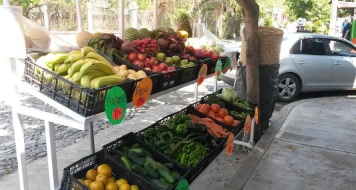
Produce section at a local tienda
The tiendas have produce but don’t expect to find a big selection or even seasonal varieties. But bananas, oranges, apples, potatoes, onions, garlic, chiles (and chiles and chiles) – you can put together a meal.
In the dairy section – which is usually part of one refrigerator – there may be a few bottles of fresh milk, a couple things of yogurt, a few selections of cheese, etc. And butter. And crema[3]. Lots of butter and crema. But that’s it – one refrigerator.
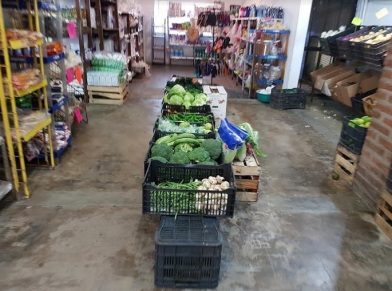
More tienda produce
And, if you don’t see what you want – ask. Tiendas have hidey-holes. Don’t see cilantro? Just ask – it may be behind the counter, or in the back in a different refrigerator. But don’t look for fresh meats or fish – more on those later when we discuss the specialty markets.
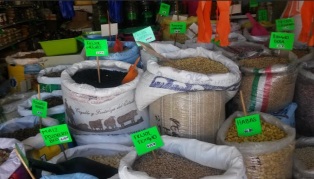
Bulk products
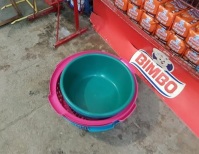
Shopping baskets
No shopping carts here. You may see a stack of mis-matched plastic tubs – pick one to carry around and fill up. Or if you are just getting a few things, you can stack them up on the counter while you run back for one or two more things. Don’t worry if the person stacking in front of you is still shopping – if you’re done, the attendant will likely take care of you first. The concept of waiting in line is pretty loose in the tiendas.
Most loose items – produce, eggs, bulk grains – are sold by weight. You choose your eggs, place them carefully in a plastic bag, and take them to the front for weighing. Once I needed large trash bags, they pulled some out from under the counter and weighed them to get a price.
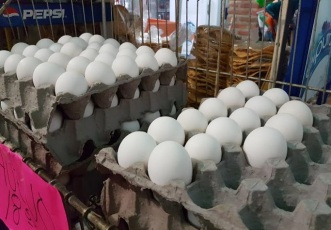
Tienda eggs, 18 pesos per kilo. I have no idea of the price per dozen, but it’s cheap compared to US.
Specialty Markets
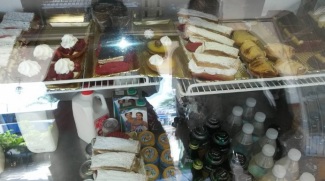
What a find – an independently owned bakery with french pastries (Bucerias). The eclairs have become a Nakamal favorite.
Or as I call them “the –erias”. Spanish for meat is “carne”, so the butcher shop is “carnicería”. Fish is “pescado”, the fish market is “pescadería”. Bread is “pan”, so there could be a “panadería” – and so forth. Here in La Cruz we have a fishermen’s section of the marina, and fish doesn’t get much fresher than off the boat and into your bag with only one middleman. They do freeze some, and one vendor at our “Mercado del Mar” (Market of the Sea) has a freezer of specialty items as well – green-lipped mussels, salmon and a few other things that aren’t local or in season.
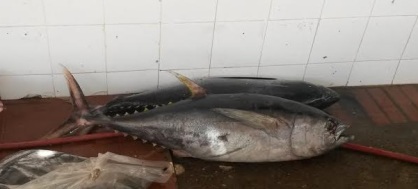
Tuna, fresh off the boat
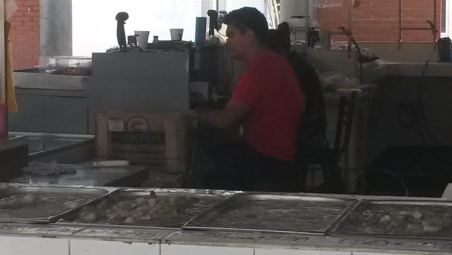
Camarones for sale at the local fish market
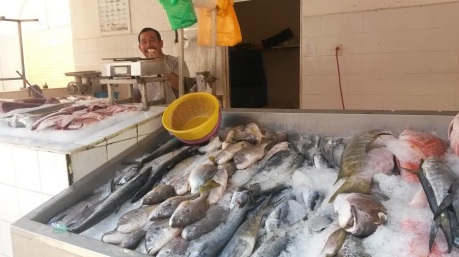
Hijan tends the fresh catch counter at the local fish market
Same with meats – I think the carnecerias buy directly from the farmer or pretty close to him, based on my observation of the delivery system. I have seen entire carcasses hanging in the shop and people with large knives and cleavers dividing them into different cuts – some are sold fresh, and some chunks are frozen for sale later. Once I ordered up some “chuletas de cerdo” – they pulled out the entire frozen rib cage, asked me how thick I wanted them and proceeded to cut them to order on a giant saw thing (no kosher at this carnicería).
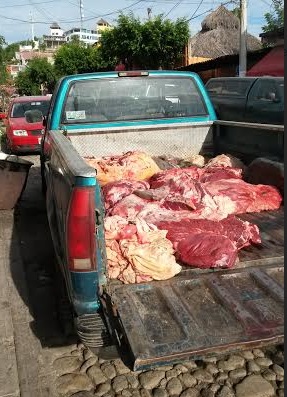
Beef and pork delivery – fresh from the ranch to the butcher?
Open Air Mercados (Markets)
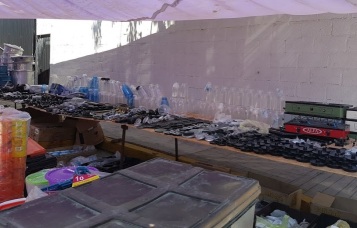
Build-a-blender
Each “pueblo” (village or town) seems to host a “pop-up” market on a weekly basis. In La Cruz, it happens on Wednesday. In Bucerias, it’s Sunday, and so on. It takes the concept of the original WalMart and recreates it under EZ-Ups or tarps. In La Cruz, there is one vendor just for kitchen items (interestingly, they have all the parts you would need to build a blender but I don’t think they sell actual blenders), another for general household things (plates, cups, buckets, brushes, clothespins, etc.), stands for clothing, movies and toys. And one produce vendor.
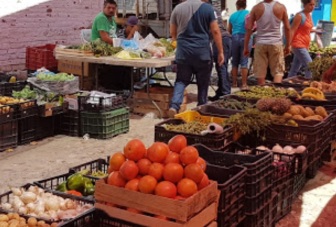
Produce shopping in La Cruz’s Wednesday market
All the produce is moved off the truck (not refrigerated that I can tell) and the crates are stacked up or the produce removed from crates and arranged on tables. It gets moved around a LOT, so is sometimes a little worse for the wear. You have to check carefully for dents and bruises. Once I brought home a head of broccoli with some bruising that I knew I could cut around, only to cut and find a big ol’ juicy worm and what looked like eggs or babies. I cut the wormy parts out, boiled it pretty well and we enjoyed broccoli that night.
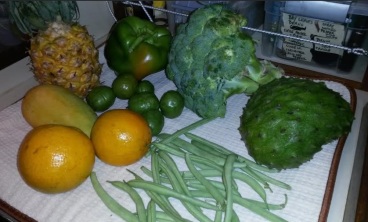
One day’s haul from the local market
Another time I picked up a HUGE bunch of acelgas[4]. It was far more than we would be able to eat and I almost asked the attendant to divide it but something made me stop (likely my realization that I didn’t have the vocabulary to ask this in Spanish). It cost on the order of $1 U.S. Once I got it on the boat and started cleaning it, it became obvious that much of it was not high-quality greens and, as greens do, it greatly shrunk in the cooking process. Between the waste and shrinkage, we still managed to get two generous portions out of the giant bunch, and it was still a bargain compared to prices up north.
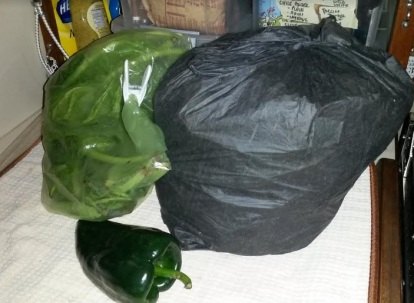
Acelgas and poblano – good stuff in the green bag, not-so-good in the black bag. Since the whole bunch was less than a U.S. dollar – still a good deal.
You just need to accept that the experience of standing in line, on the street, with the local Mexican housewives is going to net you some local color, but don’t expect the big-box store quality.
Independent Operators
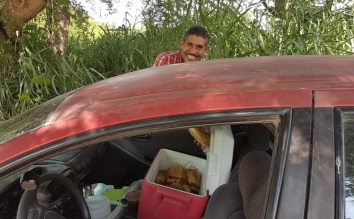
Fresh tamales from the front seat
You see these folks EVERYWHERE in Mexico – a friend of ours tells the story of being the only sailboat in an area, when they were flagged down by a “panga” (small fishing boat). The fisherman waved his red t-shirt to beckon them over, and thinking he needed assistance my friends moved toward him. Turns out that waving a red cloth is universal panga language for “I have red snapper today” and they were able to barter for some fresh catch.
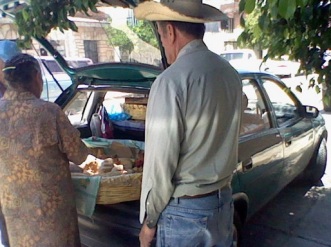
Baked goods from the trunk
On land, you may see them operating out of the back of a truck, the trunk of a car, a wheelbarrow, a basket, or a cart on the side of the road. They usually sell one thing, and only one thing like pineapple, shrimp or pastries. The bigger ones are a mobile produce stand.
There is one dude in Bucerias who has a stand that only sells certain fruits. I want to think that his family farms it, and he runs the stand which is set up in the arroyo under an overpass. Pineapples, papayas, a couple other varieties of fruit. He loads up the new stock on Sundays to coincide with the weekly market and then the stock dwindles (so do the prices!) as the week goes on.
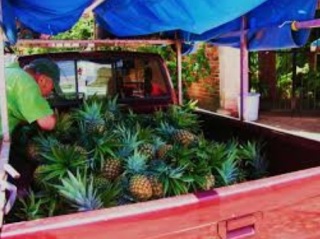
Pineapples
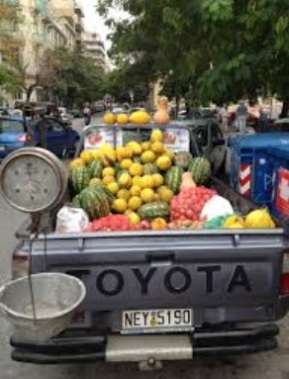
Mobile produce stand
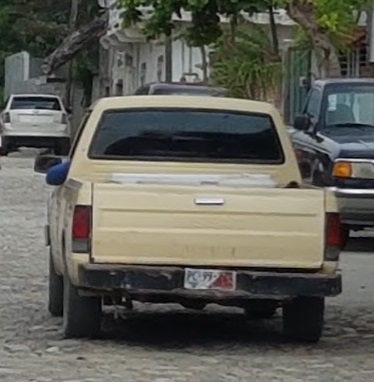
Camarones (shrimp) for sale in those coolers. I know this because the loudspeakers mounted in the windows told me so as he drove around the streets.
Being a romantic, I like to think these people are really benefitting from micro-economics – raising and selling their own products. For all I know, they are poorly-paid employees of some mega-rancher but I like my mental image better, so I’m keeping it.
Another option with these guys is the ability to bargain – you may only want one small pineapple priced at 10 pesos, but if you AND your friend want one, offer 15 pesos for two.
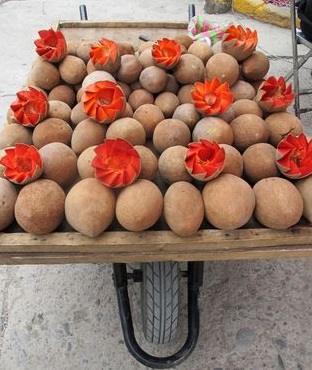
Mamays – they taste like pumpkin!
Muling Stuff From Back Home
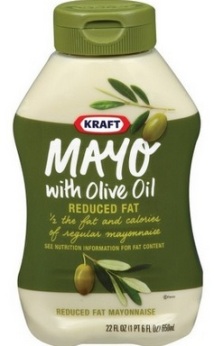
We cannot find this in Mexico!
The last-ditch of provisioning options – things you just can’t find anywhere. If, like us, you are in Mexico on the 180-day visitor’s visa, then at some point you may be leaving and re-entering. Or, you may have friends or family coming down to spend time out of the harsh winters. In that case, stuff those suitcases with the things that you must have, but can’t find. Be sure to double check Mexican customs web-sites so you don’t go to the trouble only to lose your precious cargo at customs!
—————————————————————–
FOOTNOTES
[1] One general note – I have not seen any locals haggling over food prices, or for any items in the tiendas. Non-perishables in the open air mercados – clothing, household goods, toys, etc. – are another story. If you enjoy bargaining, give it a try. In the tourist markets bargaining is expected and trust me, the first price they give you includes lots of room for discounting.
[2] A word of caution – sometimes the stock is displayed in open bins or even barrels. Even if it’s bagged up, it probably originated from the same bulk source as the stuff in the open. We recently had a creepy-crawly experience where I opened one of our food lockers and found small black bugs. Lots of them. Crawling around. We finally located the source – a small plastic bag of “trigo en grano” (wheatberries) that I bought out of an open bin about three months prior. They had eaten through the plastic bag, escaped the plastic bin that held the bag, and were on their way to the locker next door. Ugh.
[3] Hint: look for something labeled “crema” with the word “acidificado” on it. That’s sour cream.
[4] I learned the name of this mysterious leafy green from one of the local tienda owners. Sadly my Spanish isn’t good enough to discuss how to prepare it, but once she spelled it for me, online research led me to try it out and voila – a new leafy green vegetable option in our food plan!

Grain weevils = boat evils.






OMG how interesting
Had a good day with your mom went to walmart and the movies and applwbees
LikeLike
It is a different experience here, that’s for sure.
LikeLike
Hi! Are the prepared ones your creations? What beautiful presentation! Makes you hungry to look at them. Afraid I’d have trouble shopping from the truck bed, etc. But otherwise very interesting! Is that John waiting for the bakery goods? Love to read these, keep them coming!
LikeLike
The really pretty ones are from restaurant meals. It’s not John awaiting baked goods, just some random dude on the street.
LikeLike